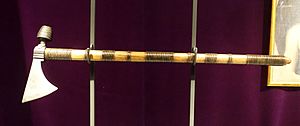Treaty of Easton facts for kids
The Treaty of Easton was an important agreement signed in October 1758. It happened during the French and Indian War, also known as the Seven Years' War. This treaty was made between British colonists and the leaders of 13 Native American nations. These nations included the Iroquois, Lenape (also called Delaware), and Shawnee tribes.
The talks lasted for over a week. They ended on October 26, 1758, in a special ceremony in Easton, Pennsylvania. The governors of the British colonies of Pennsylvania and New Jersey were there. So were representatives from the 13 Native American nations. The Iroquois sent chiefs from three of their nations. The eastern and western Lenape (Delaware) were represented by two chiefs and other leaders. Shawnee people and others also attended. More than 500 Native Americans came to the outdoor ceremony. The main goal was to bring peace to Pennsylvania, New Jersey, and the Ohio Country region.
Conrad Weiser helped the British colonial governments by being an interpreter. He also helped settle disagreements. Charles Thomson worked as a secretary and advisor for Teedyuscung. Teedyuscung was known as the "King of the Delawares." These talks aimed to fix problems caused by something called the Walking Purchase of 1737. That event had a long-lasting impact on how Native Americans and colonists got along.
Contents
What the Treaty Said
The Treaty of Easton had several key points. First, the Native American nations agreed not to fight with the French against the British. In return, Pennsylvania gave back large areas of land. The Iroquois had given up this land a few years before.
Promises for Native American Lands
The British colonial governors also made important promises. They agreed to respect the Iroquois and other tribes' rights to their hunting grounds. These lands were in the Ohio River valley. The British also promised not to build new settlements west of the Allegheny Mountains. This would happen after the war ended. This part of the treaty later helped lead to the Royal Proclamation of 1763. This Proclamation tried to keep land west of the Appalachian Mountains for Native Americans. It also stopped European-Americans from moving into that area.
Direct Talks with the Lenape
In addition, William Denny, the colonial governor of Pennsylvania, agreed to talk directly with the Lenape-Delaware. This was important because it meant the Iroquois would not be involved in these specific talks. This agreement was marked by "rekindling a council fire." This was a traditional way to show peace and renewed friendship.
The Treaty's Outcome
The conference finished on October 26, 1758. In November, Governor Denny told the Pennsylvania Assembly that "a general peace was secured at Easton." This meant the treaty was a success.
Land Claims in New Jersey
Through this treaty, the Lenape gave up all their remaining claims to land in the Province of New Jersey. They received one thousand Spanish dollars for this land. They were paid right away.


